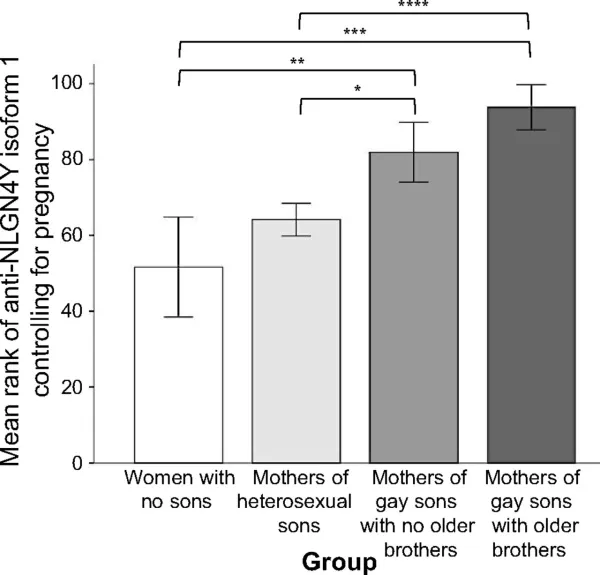Association Between FBOE and Anal Sex Role Tested
The great tragedy of Science—the slaying of a beautiful hypothesis by an ugly fact – Thomas Henry Huxley 1870
A paper published just days ago, tested, attempted to replicate Wampold’s observation that the Fraternal Birth Order Effect was predominantly found only in “bottoms”. The hypothesis didn’t hold, a beautiful hypothesis slain by an ugly fact. I had previously cited Wampold’s paper, along with other observations. This was only one piece of data that showed that there was a correlation between “bottom” gay men and Homosexual Transsexuals (HSTS).
“Contrary to some earlier reports, however, our data did not establish the FBOE as exclusive to gay men with the receptive AERO.”
But there are other statements in the paper that I would point out and address. The authors cite and discuss many of the same papers and evidence regarding the potential multiple etiologies of male androphilia beyond the FBOE including familiarity and excess left-handedness that I have covered in past essays. It is heartening that these studies are being taking seriously and explored carefully.
“Yet there is another complementary possible explanation (not necessarily contradictory to the MIH), which has not received much theoretical attention so far. As Haig (2014) outlined, there is a potential that older siblings may influence their younger siblings’ physiology through fetal microchimerism. Fetal microchimerism is a naturally occurring state in which fetal cells, after crossing the placenta, engraft into various tissues in the maternal organism (Cómitre-Mariano et al., 2022). In many cases, the physiological function of these engrafted cells of fetal origin is not clear–they may probably serve as a beneficial factor in maternal health but are also believed to contribute to autoimmune diseases (Cómitre-Mariano et al., 2022). In the development of human sexual orientation, cells of older brothers engrafted in maternal tissues might (1) contribute to the continuous production of antibodies against male antigens or, which is highly speculative, (2) even re-cross the placenta, enter the younger siblings’ bloodstream and alter their physiology directly (see also Haig, 2014). Obviously, other ways these cells could exert their influence are conceivable. Still, the cardinal background assumption, i.e., mothers of homosexual men having a higher amount of male microchimerism in comparison with mothers of heterosexual men, remains to be tested empirically.”
Hmmm… I seem to recall that someone else wrote about this very possibility BEFORE Haig’s 2014 paper, in 2013… oh yeah! That was ME!
However, that is not the only comment in the paper which I would caution a casual reader to examine the data, the evidence, before accepting it on face value,
“The FBOE in gay men is usually explained by the maternal immune hypothesis (Blanchard & Klassen, 1997), which was proposed as a sex-asymmetrical immunological cause of male homosexuality. It assumes that cellular, protein-containing material from embryos or fetuses of the male sex can permeate the placenta, enter maternal bloodstream, and lead to an antibody-mediated immunological response to male-specific antigens. When the woman is pregnant again, these antibodies cross the placenta, invade the unborn child’s circulation, and alter some of the child’s physiological functions. The levels of maternal antibodies are supposed to increase with each subsequent pregnancy with a male fetus. The validity of the maternal immune hypothesis was partly corroborated by the only direct test to-date (Bogaert et al., 2018), which found that the blood levels of anti-NLGN4Y (neuroligin 4 Y-linked is a male-specific cell-adhesion protein present in neural synapses) antibodies are higher in the mothers of gay sons than in the mothers of straight sons or no sons. Nevertheless, the study did not find a significant difference between the mothers of gay sons with older brothers and mothers of gay sons with no older brothers (for anti-NLGN4Y isoform 1 or significance-bordering results for isoform 2 or isoforms 1 and 2 combined), which presents a challenge for the maternal immune hypothesis (Valentova et al., 2023).”
The statement that Bogaert, “did not find a significant difference between the mothers of gay sons with older brothers and mothers of gay sons with no older brothers … which presents a challenge for the maternal immune hypothesis” is misleading on several grounds. I wrote an essay on this very study and take issue with the largely unspoken assumption that the FBOE mediated by maternal immune factors would only effect later born sons. The data shows that it effects even the first born son. That is, the nine months of pregnancy is long enough for the mother to have developed such immune factors that directly effect first born sons and thus their sexual orientation.
This exemplifies and illustrates something that I’ve said for years, “Don’t accept statements of conclusions as facts in science papers.” Remember the motto of the British Royal Academy of Science, ‘Nullius in verba’ (Take no one’s word for it). Or as we say in America, “In Data We Trust – All Other’s Bring Evidence”.
Further Reading:
Common Correlations in HSTS and Gay Men
On The Etiology of Homosexual Transsexuality
Etiological Conjectures, Part 3 (Essay on microchimerism as an alternate explanation of the FBOE)
Fraternal Birth Order Effect Applies to First Born Male Children Too
Reference:
Fořt, J., Kunc, B., Valentova, J.V. et al. Examining the Fraternal Birth Order Effect and Sexual Orientation: Insights from an East European Population. Arch Sex Behav (2024). https://doi.org/10.1007/s10508-024-02892-8

Comments Off on Association Between FBOE and Anal Sex Role Tested